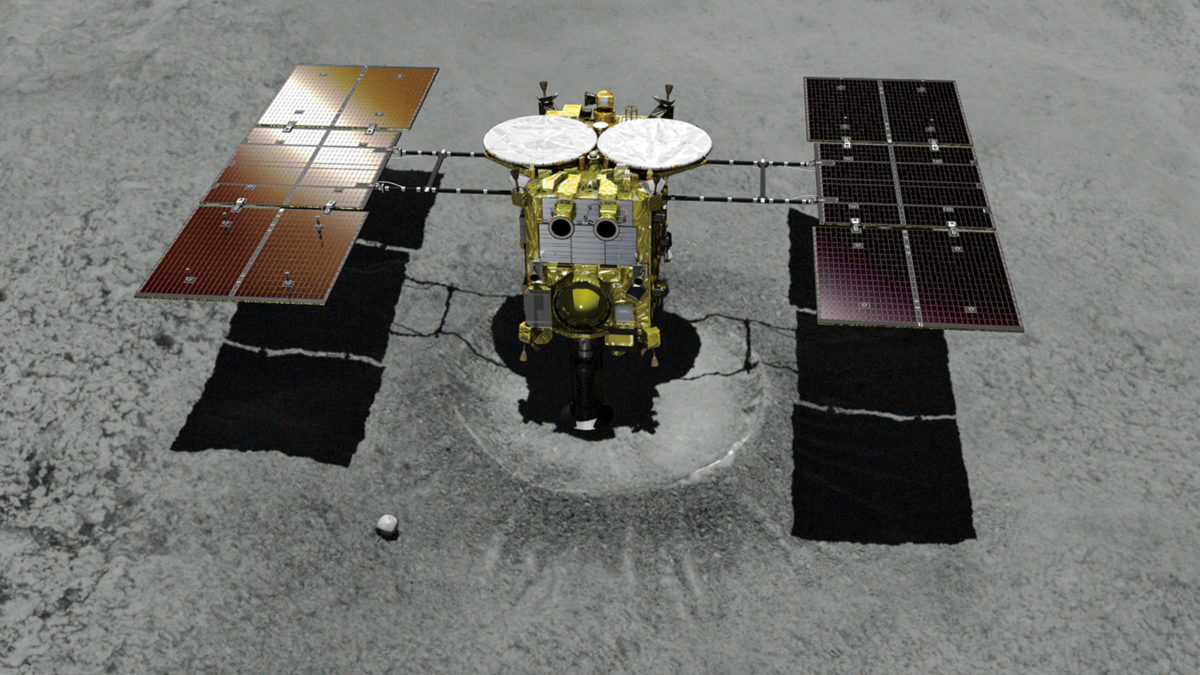Waiting begins as Japan’s Hayabusa-2 probe releases rovers toward asteroid target
By Tom Risen|September 21, 2018
If the rovers reach the surface, they will deliver photos and more
UPDATE: The Japan Aerospace Exploration Agency confirmed on its website Sept. 22 that both Minerva-2 rovers had landed on the asteroid Ryugu and “are in good condition and are transmitting images and data.”
Japan’s second asteroid-sampling spacecraft, Hayabusa-2, on Friday released a canister that began drifting slowly toward the surface of the asteroid Ryugu with two disc-shaped rovers inside.
The fate of the canister and rovers could be unknown for several days, because as Ryugu rotated, its gravity pulled the canister along with it as expected, temporarily blocking communications from the canister and rovers to Hayabusa-2, said a Japanese official who was monitoring the mission in Washington, D.C.
If all goes well, these rovers, will soon spring free and start hopping across the surface, taking photographs and temperature measurements as part of Japan’s quest to find water and carbon compounds and return samples of Ryugu to Earth.
Scientists suspect that asteroids like Ryugu might have played a part in creating the oceans of Earth, while also delivering the carbon compounds that are the organic ingredients of life. Hayabusa-2 could provide evidence to support or refute that theory.
The spacecraft, built by Tokyo-based NEC Corp. for the Japan Aerospace Exploration Agency, has been orbiting the asteroid since June.
The canister separated from the spacecraft at 1:30 p.m. Tokyo time on Friday, according to JAXA’s Twitter feed. At 6:30 p.m. Tokyo time, the Twitter feed reported that the canister was on the far side of Ryugu and that Hayabusa-2 would temporarily be unable to relay signals through the spacecraft to Earth.
Masami Onoda, director of JAXA’s office in Washington, D.C., said the canister would be pulled “very slowly” toward the asteroid by its weak gravity, and that after landing “a spring mechanism will open the cover and disc-shaped rovers would hop out.”
Wheels cannot work on the surface because of Ryugu’s low gravity, so these two rovers designated Minerva-2 1A and the other 1B, will hop over the surface propelled by electric motors. JAXA estimates that each hop will last 15 minutes and cover 15 meters on average.
The rovers are similar to the first Minerva (short for Micro Nano Experimental Robot Vehicle for Asteroid) carried by the original Hayabusa spacecraft, which in 2005 arrived in orbit at the asteroid Itokawa. This version of Minerva drifted into space instead of reaching Itokawa’s surface, but Hayabusa (“peregrine falcon” in English) went on to deliver an asteroid sample to Earth in 2010.
Onoda said the situation looks better for Minerva-2 1A and 1B, and that JAXA controllers would announce updates in the coming days once the spacecraft re-establishes a signal with the rovers.
Before the canister was released, Hayabusa-2 scanned Ryugu’s surface with its Optical Navigation Camera–Telescopic to look for candidate sites that would be flat enough for a safe landing for the rovers, which were built for JAXA by a consortium of companies and universities in Japan. Infrared spectral filters on the camera also looked for signatures of water within the surface regolith or beneath it, to find options for the next steps in the mission: another landing, an additional rover deployment and two sample collection attempts.
In the next major step, Hayabusa-2 on Oct. 2 will begin approaching Ryugu in preparation for releasing a lander called Mascot (short for Mobile Asteroid Surface Scout) on Oct. 4. Mascot was built by the German Aerospace Center and CNES, the French space agency. It will autonomously take photographs and measurements with its magnetometer, radiometer and hyperspectral microscope.
Also in October, plans call for Hayabusa-2 to briefly touch down in the first of two sample collections maneuvers, this one aimed at gathering surface material. A horn at its base will collect the sample at a date still to be chosen, and then return to orbit.
Ryugu is close enough to the sun that surface water would have evaporated, but “there could be water within the minerals on the near surface,” says Vishnu Reddy, professor of planetary sciences at the University of Arizona’s Lunar and Planetary Laboratory in Tucson.
JAXA will attempt to collect a subsurface sample in 2019, when Hayabusa-2 releases a canister containing a projectile that will create a hole in the asteroid. Hayabusa-2 will then try to collect a sample from the hole before carrying all its samples back to Earth.
Also in 2019, JAXA plans to deploy a third rover, MINERVA 2-2.
The JAXA illustration at top is of the Hayabusa-2 satellite.






